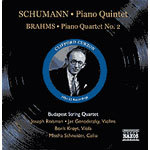
Schumann: Piano Quintet, Op. 44 / Brahms: Piano Quartet No. 2 (Rec 1951-1952)
 $25.00
Out of Stock
$25.00
Out of Stock6+ weeks add to cart
ROBERT SCHUMANN / JOHANNES BRAHMS
Schumann: Piano Quintet, Op. 44 / Brahms: Piano Quartet No. 2 (Rec 1951-1952)
Clifford Curzon (piano) / Budapest String Quartet
[ Naxos Historical / CD ]
Release Date: Tuesday 1 March 2005
This item is currently out of stock. It may take 6 or more weeks to obtain from when you place your order as this is a specialist product.
The Budapest Quartet made four recordings with Curzon in 1950-53, the present two and the quintets of Brahms and Dvoøák.
Robert Schumann never wrote anything better than his Piano Quintet, one of the most perfect creations in Western music. In fact he virtually invented the form as we know it: the quintets of Boccherini were arrangements and those by Hummel and Schubert incorporated a double bass. Schumann had such success in combining a piano and a string quartet that many other composers followed suit, among them Brahms, Dvoøák, Franck, Fauré, Reger, Martucci, Elgar, Bloch, Reizenstein, Toch, Martinu° and Shostakovich.
The quintet was the prize production of Schumann's 'chamber music year', 1842, in which, after an intensive study of classical works, he also wrote three string quartets, a piano quartet and some pieces for piano trio. The quintet, intended for his wife Clara and dedicated to her, was finished in October and incorporated musical signatures with deep significance for the Schumanns. The most obvious is the double drop of a fifth which can be heard in the first trio of the scherzo and elsewhere: it harks back to the Impromptus on a Theme by Clara Wieck, Op. 5, based by Schumann on a Romance which Clara had written for him. Then there is the near-quotation of the aria 'Es ist vollbracht' from Bach's St John Passion, heard just after the first movement's exposition and again in the slow movement. Hans Kohlhase has convincingly argued that the quintet commemorates the painful four and a half years during which Robert and Clara were forbidden by her father to marry. It is clearly influenced by his admiration for Schubert's E flat Trio; but Schumann makes everything his own. The first movement has a marvellously bold first theme and a meltingly romantic second subject. The slow movement is a funeral march, as in Schubert's trio. The scherzo is based on a simple chromatic scale - of such touches are geniuses made - and the finale is a magnificent construction, ending with a masterstroke in which its main theme is combined with the opening theme of the whole work. The quintet is a portrait of Clara on two levels; the virtuosic piano part reflects her status as one of the great nineteenth-century pianists, and the lovely phrases given to the viola surely represent her more private self, the Clara that Robert knew.
We do not know what contributions Clara, a superb critic, made to the work, but we do know that Schumann's friend Mendelssohn made a crucial intervention. The very end of the work, with its contrapuntal tour de force, was probably inspired by Mendelssohn's quartet in the same key. Then, by a lucky mischance, Clara was unwell when the first private performance was given on 6th December 1842, and Mendelssohn played the fiendish piano part, which hardly ever lets up, at sight. He made astute suggestions for improving the slow movement and the scherzo: adding a second trio was his idea. Clara played in the first public performance on 8th January 1843, by which time the quintet had been revised, and pronounced it 'splendid, full of vigour and freshness'. It was published on her birthday, 13th September 1843.
The Budapest Quartet worked with many fine pianists, among them George Szell, Artur Balsam, Miecyzslaw Horszowski and Rudolf Serkin. A favourite was the Englishman Clifford Curzon (1907-82), who studied with Charles Reddie at the Royal Academy of Music in London, and later with the Leschetizky pupils Katharine Goodson and Artur Schnabel. After two years in Berlin with Schnabel, Curzon went to Paris, where Wanda Landowska and Nadia Boulanger influenced him. He made his United States début in 1939 and after the war was recognised as one of the great pianists. He was made CBE in 1958 and knighted in 1977.
The Budapest Quartet made four recordings with Curzon in 1950-53, the present two and the quintets of Brahms and Dvoøák. In addition live recordings of the quintets by Schumann (1951) and Franck (1956) and the E flat Quartet by Mozart are known. The Columbia recordings had to be taped in the boxy acoustic of the Library of Congress concert hall, as a condition of using the Library's Stradivari instruments. The string players' essential warmth and Curzon's aristocratic pianism, however, still make their effect.
